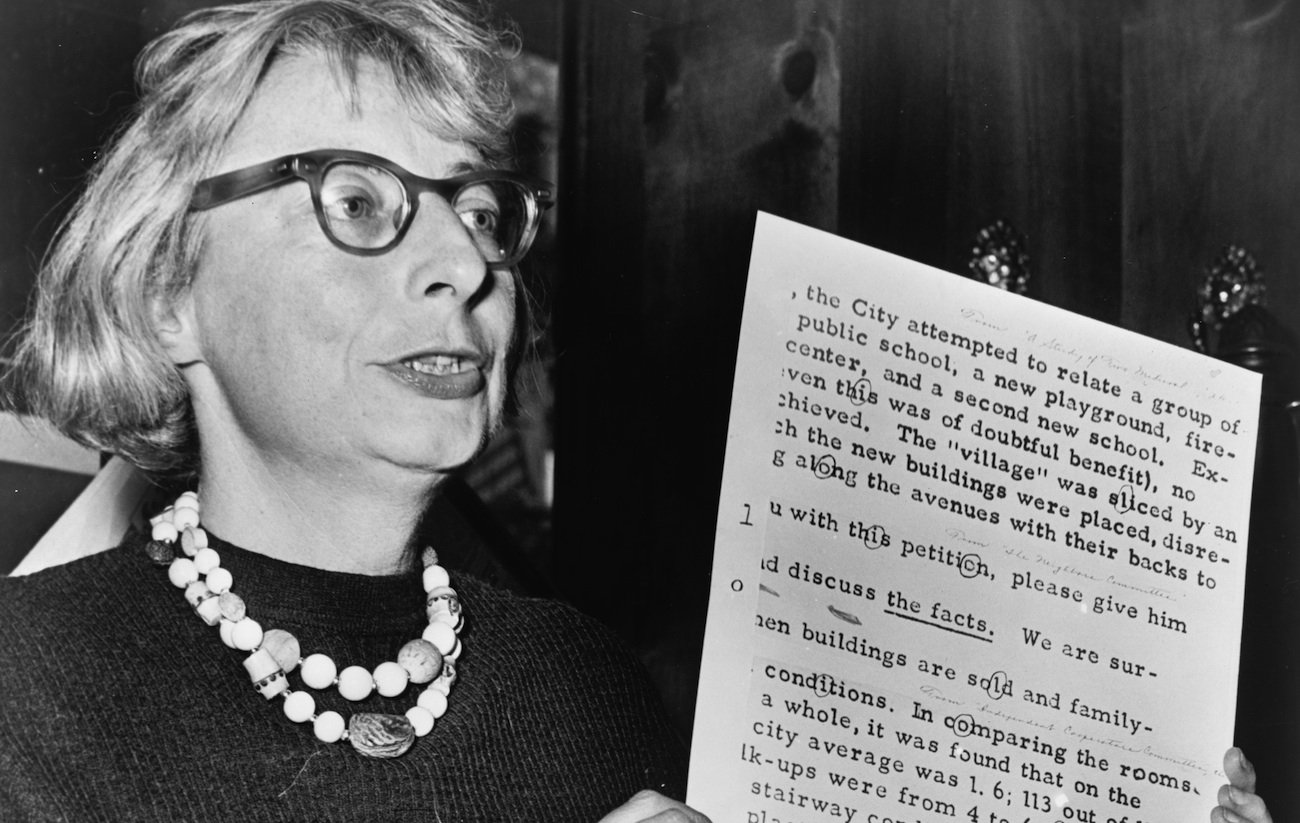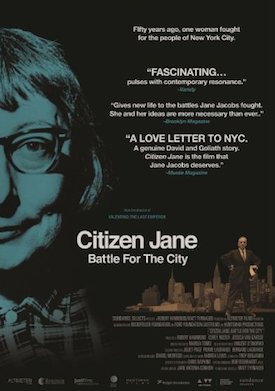 Citizen Jane: Battle for the City is a fascinating and important look at what can happen when engaged citizens fight the power for the sake of a better world. Few people did more to shape our understanding of the modern American city than Jane Jacobs (1916-2006), the visionary activist and writer who fought to preserve urban communities in the face of catostrophic development projects. Director Matt Tyrnauer (Valentino: The Last Emperor) vividly brings to life Jacobs’ 1960s showdown with ruthless construction kingpin Robert Moses over his developments that would have devastated New York City, including his plan to raze lower Manhattan to make way for a crosstown highway. It’s a dramatic struggle over the very soul of the city, and one that we can learn a lot from today. I sat down with director Matt Tyrnauer at his Los Angeles office.
Citizen Jane: Battle for the City is a fascinating and important look at what can happen when engaged citizens fight the power for the sake of a better world. Few people did more to shape our understanding of the modern American city than Jane Jacobs (1916-2006), the visionary activist and writer who fought to preserve urban communities in the face of catostrophic development projects. Director Matt Tyrnauer (Valentino: The Last Emperor) vividly brings to life Jacobs’ 1960s showdown with ruthless construction kingpin Robert Moses over his developments that would have devastated New York City, including his plan to raze lower Manhattan to make way for a crosstown highway. It’s a dramatic struggle over the very soul of the city, and one that we can learn a lot from today. I sat down with director Matt Tyrnauer at his Los Angeles office.
Danny Miller: What a riveting documentary! I was totally shocked at how close we came to losing such iconic and beloved parts of New York such as Washington Square and Soho. Do you think most New Yorkers know about this?
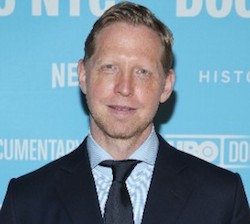 Matt Tyrnauer: Oh, no, not at all. Gore Vidal used to refer to this country as the United States of Amnesia. But there’s no question that Robert Moses was targeting two of the most popular parts of New York City today: Soho and Greenwich Village. He was trying to destroy them. At the time the West Village and parts of Soho were considered slums, but, of course, now it’s inconceivable to think of New York without those areas.
Matt Tyrnauer: Oh, no, not at all. Gore Vidal used to refer to this country as the United States of Amnesia. But there’s no question that Robert Moses was targeting two of the most popular parts of New York City today: Soho and Greenwich Village. He was trying to destroy them. At the time the West Village and parts of Soho were considered slums, but, of course, now it’s inconceivable to think of New York without those areas.
Which proves what a visionary Jane Jacobs really was, that she saw the value in these neighborhoods even if many people didn’t back then.
Exactly. That is really her biggest legacy. Jane Jacobs saw the brilliance of cities even when they were at their low point — and she understood the city in a much different way than the conventional wisdom of that time. This is why she’s worth knowing about. You can look at her legacy in two parts: as a brilliant author and journalist who wrote a classic book, The Death and Life of Great American Cities, which was published in 1961, but also an activist, which is an aspect of her legacy that is more relevant than ever in today’s political climate. She practiced what she preached and she took her concepts of the city, which were considered avant-garde at the time, and applied them in a spate of activism in the 1950s and 60s that was part of the story of the salvation of New York City from the bulldozers of Robert Moses.
It’s amazing how little known she is today considering the effect her work had on how we view cities today.
There’s no question that her book and her activism had an echoing effect across the nation and the world. She had a major role in changing the doctrine of urban planning and the way we think about cities.
It’s so easy to see developer Robert Moses as a true villain in the film. Stepping away from today’s sensibilities for a second, can you look at any of his actions in New York and ascribe any noble motives to his projects? Getting rid of disease and squalor or finding ways to help the poor?
Well, there’s good Robert Moses and bad Robert Moses, and for me you can draw the line roughly at World War II. In the early part of the 20th century, Moses was part of the progressive movement in New York. This is very important and part of the brighter side of his early legacy which, unfortunately, was mostly erased by the second half of his legacy. The progressive movement formed to help the poor and disenfranchised — we know that most cities were terribly overcrowded and rife with disease and many social problems, and that there was no social safety net in the country to address these things. So the progressives spearheaded this — people like Eleanor Roosevelt and many others, including Robert Moses.
So what went wrong?
What happened is that the progressive movement was slowed down by the Great Depression and the Second World War — everything is put on hold. And then, afterwards, this command and control style , the notion of a Big White Man in Charge top-down vision of how to run the world pervades because that’s how we won the war. Robert Moses was relatively mature in his career at this time and very powerful and he starts to apply this top-down methodology to a kind of progressivism writ large that’s funded by federal dollars and he proceeds to remake the city in this sweeping way that Jane Jacobs soon realizes is extremely dangerous, if not evil. One of her great lines from her book is, “Urban renewal is not the saving of cities, it’s the sacking of cities.” This was a very radical notion in the 1950s and 60s.
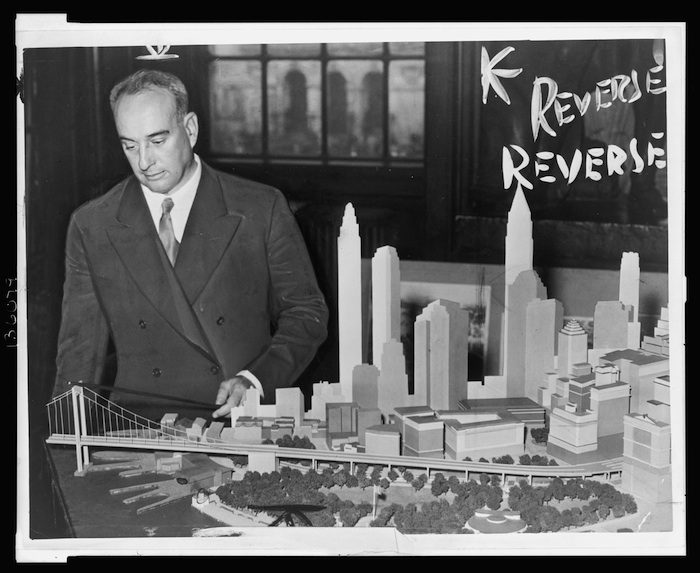
I can imagine how many people at the time saw things like the low-income housing projects that went up during this period as a good idea and yet we now know they were immediate failures. I’m from Chicago, and thank God we’ve seen most of these structures come down in recent years. But at the time do you think Robert Moses and others truly believed that buildings like this were good modern alternatives to the ramshackle tenements?
Oh, it’s very complicated. There were no monolithic answers to these problems, and an important part of Jane Jacobs’ legacy is the idea that these one-size-fits-all approaches to the issues of city squalor and urban decay were ill-founded. The ideas of Le Corbusier which were founded on noble ideas of getting people out of slums seemed very sexy and modern in the 1920s and 30s when they were introduced. Le Corbusier was a great marketer, really, his drawings were great looking, the sleek modernism of these schemes was very attractive, and people were ready for something new. When it came to the matter of city planning, everyone bought into it, and there’s no question it was much cheaper to build.
And with the changing technologies of the time, I’m sure it seemed to make the most sense to build up.
Right, certainly with the invention of the elevator. All of things were coming together — why not try something new? I’m sure it all seemed terribly exciting at the time. But the way that it was implemented was deeply flawed. Wipe the slate clean, and it also involved a kind of social engineering. If you’re doing that in the name of some utopian project, which is sometimes what they were professing to do, fine, maybe that’s a decent experiment, but they very quickly saw that things weren’t going right. Jane Jacobs saw this very early, as these projects were starting to be built. So why didn’t the whistle get blown, why did it all continue for so long? I would venture to say that the reason it didn’t get changed is because the people who were using these projects, the people they were being built for were generally minority populations.
With no power whatsoever.
Right. They didn’t have a voice, and the system was rigged against them. As James Baldwin said at the time, “Urban renewal means Negro removal.” A sociologist in our film says that what Baldwin means is this was an assault that meant that if you were African American you should go someplace over there and die. I think that’s a harsh reality we have to reckon with. Many of the projects did have that as a result.
So what might have started out as a progressive idea quickly turned into something much more nefarious.
Yes. Jane Jacobs saw that and wrote a book about it, but it took a long time for people to absorb this reality that she was presenting. Eventually it did get absorbed.
And now, in Chicago, for example, I know that many of the old high-rise housing projects are being replaced by low-rise housing.
Exactly. And it’s not unreasonable to say that you have Jane Jacobs to thank for that. People like Robert Moses were saying, “If you don’t build tall, you can’t get enough people in.” But even back then Jacobs was saying that this was simply not true.
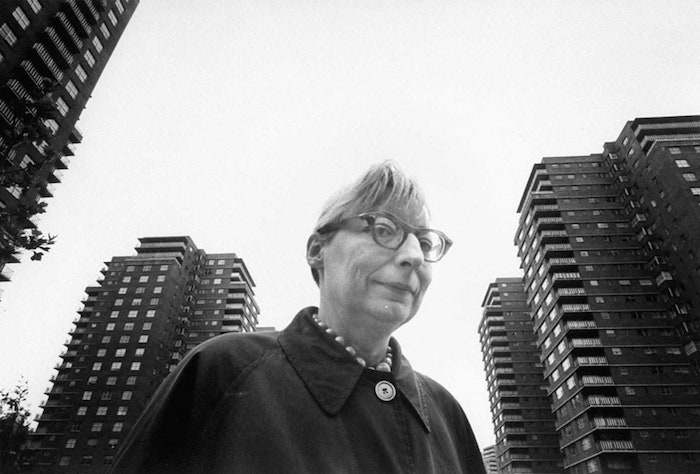
And her other ideas about what makes a functioning city were fascinating.
Jacobs doesn’t just focus on crime and the decay of the projects, she talks about the city as being a lively, interesting place, and a lot of what she assailed planners for was building dull, regimented, antiseptic environments. She believed that cities were social networks and the results of individuals each doing their own thing and mutually supporting each other. And when everyone contributes and there’s that kind of diversity and individuality, it functions like a mega-organism made up of many individual parts — that’s the miracle of the city. The “clean slate” solutions to urban problems eradicate all of that social capital and destroy the city. That was her major point.
And apart from all her issues with the negative aspects of the social engineering that was attempted, thank God her actions led to so many amazing buildings being saved from the wrecking ball — buildings that could never be replaced.
Yes, if you look at what Le Corbusier wanted to do in Paris, the section that certain buildings he wanted to build were intended to replace, it was the Marais, sort of the Soho of Paris. You can see that these architecturally significant and very beloved parts of cities were the places that were on the chopping block in the middle of the last century. And now it seems like utter madness, just as it seems like utter madness to have torn down Penn Station, but there was this “out with the old, in with the new” groupthink at the time that was sexy and appealing, It was marketed and there was a lot of big money behind it.
Was Robert Moses directly involved in the building of New York’s Lincoln Center?
Very much so, he was the driving force behind it.
Today there’s this mythology of how it replaced these horrible slums and that at least Lincoln Center was something that could be enjoyed by everyone, something that could conceivably benefit the whole city. Did Jane Jacobs fight against that development, too?
Oh yeah, she was very displeased with Lincoln Center.
Maybe my feelings are different about something like Lincoln Center because I’ve had many good theater experiences there, it’s not just some hideous rectangular office buildings that I’d never step foot in.
Well, before you and I were born, there was another metropolitan opera house that was near Times Square, the New York Symphony was in Carnegie Hall — another building that was supposed to be torn down but thankfully never was, the ballet was at City Center. Why not have those beloved institutions scattered around the city, why do you need them all in the same place? You need them all in the same place because someone like Robert Moses said you did. And he wanted to get rid of an area that was called San Juan Hill that was mostly Puerto Rican, and he didn’t care about those people or those homes. If you want to see what it looked like, it’s where they actually shot the movie West Side Story after all the houses had already been cleared out. It was made up of all of those wonderful brownstones that still exist farther up on the Upper West Side.
Okay, you’ve convinced me, I’m removing my approval of Lincoln Center! The miracle of Jane Jacobs is that she was actually able to fight against these big money interests and win some of these battles.
The system was rigged, which is why I think people are seeing Jane Jacobs’ lessons as so relevant to look at today. If you’re on the left side of things, you can see that Trumpism is all about collusion between rich people and government or in this case the fat cats taking over the government and making it into a kleptocracy. Robert Moses was a manifestation of that. In his case, I don’t think he cared about personal enrichment as much as he cared about power. But he made a hell of a lot of other people rich. For anyone in that period who was in the real estate game, Moses was your friend. That was the establishment, and the fix was in. It’s a sad story that continues not only in this country but around the world, and the poor are usually left out of the equation. That is one of the huge value of Jane Jacobs — explaining that to us in clear, understandable language and giving us a model for social action that can short-circuit that rigged system.
I don’t think you mention him by name in the film, but how does Donald Trump fit into this narrative?
Trump and Moses are similar. They’re both sons of New York privilege who never had to work for a living but were workaholics who were very interested in their own aggrandizement. But the comparisons only go so far because I think Robert Moses was actually a genius and a great intellect, somehow who could recite Shakespeare and Shaw from memory. I think Moses went very much off the rails, but you can’t make intellectual comparisons between them. Still, some of their instincts were very similar. They knew how to work the system, they knew how to work the media, and they both managed their public profiles very carefully.

